Bionic hands: history, future and reality
Losing any limb or any organ for a person is a big problem. In some cases, it has to be tolerated, but sometimes modern prosthetics can make a person “with disabilities” a person with “added capabilities”, as expressed by representatives of some companies in this industry.
In this article we will talk about hand prosthetics. Here we will not touch the topic of the teeth, eyes, ears, face, internal organs of a person and even the legs. And let's start from the Middle Ages, when amputation was one of the most effective ways to fight infections. The theme will continue the devices of the Victorian era and modern bionic prostheses, and at the end we will discuss the future of this area.

This prosthetic arm, made of steel, dates from the 16th century. It has double fingers and a thumb, which can take certain positions. The control took place with the help of a button on the back of the palm. This device is one of the three Chevalier prostheses Götz von Berlichingen . The device allowed to take objects in their hands and, perhaps, even to write with a pen.
')
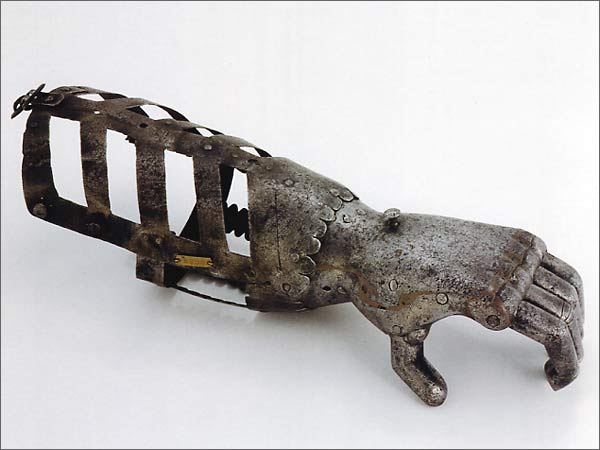

This is another hand knight .
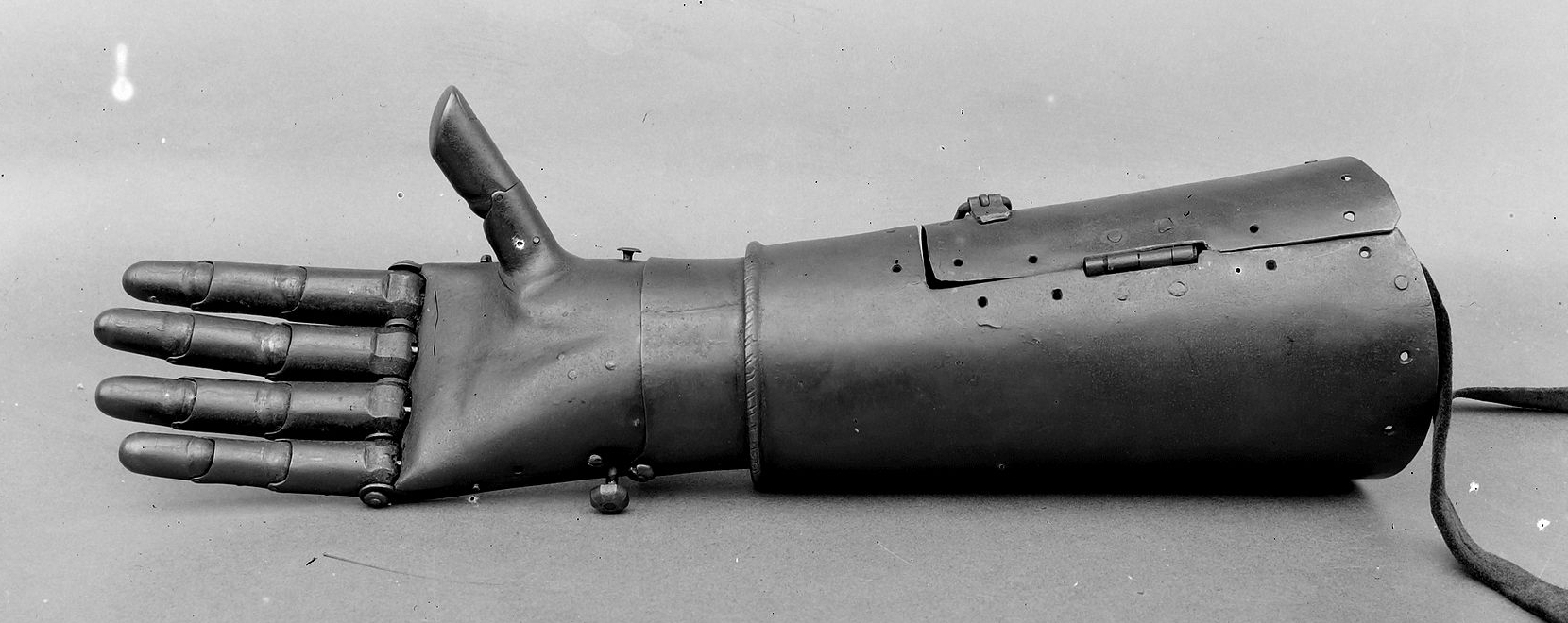
Inside this iron arm , made in the 17th century, there was a mechanism that allowed the rest of the arm to bend to control the clenched fist. This was apparently the prototype of modern traction prostheses.
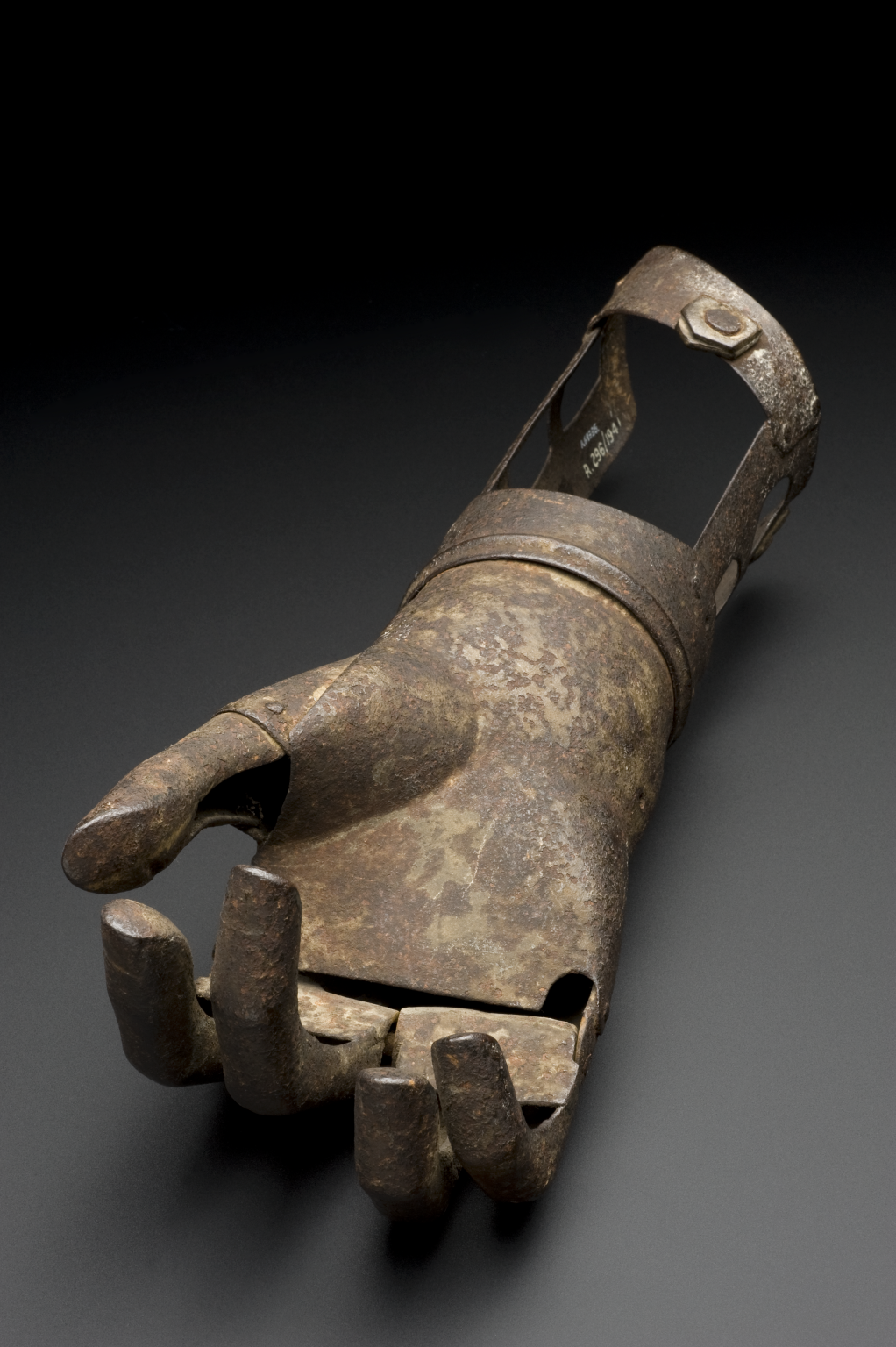
This wooden prosthesis was supposedly made in 1800.
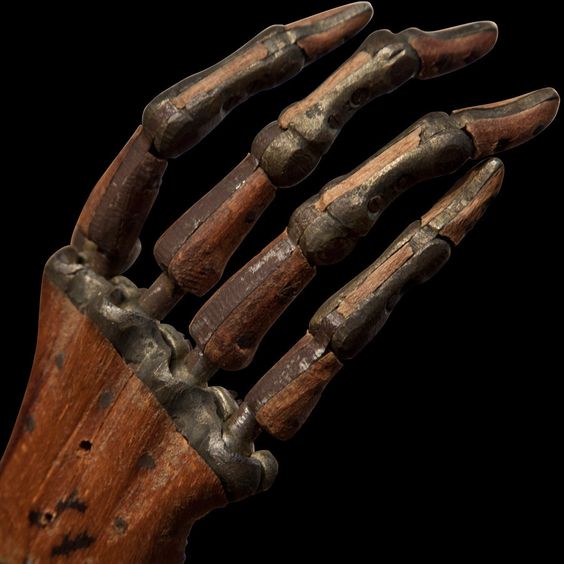
Another wooden prosthesis allegedly controlled with a cable. The artificial arm is represented in the Smithsonian Museum.
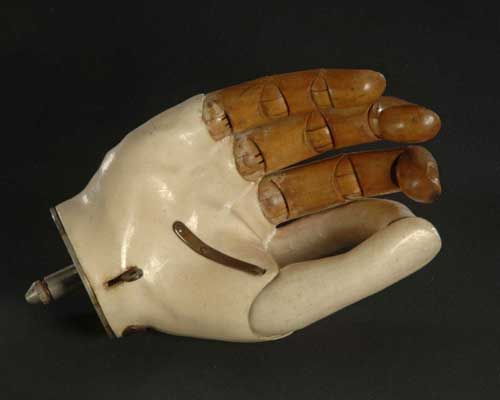
Source: invention.smithsonian.org
Less wealthy people could use hook prostheses like this device from the beginning of the 19th century. When I took this article, I was sure that only such prostheses were before the XX century.
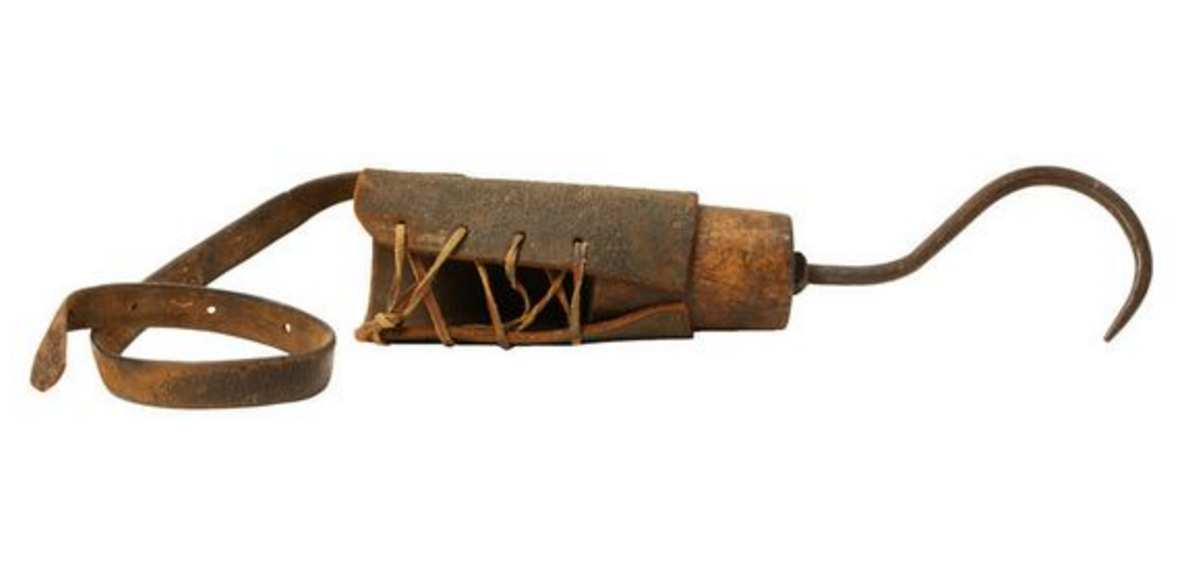
The elbow, wrist, and fingers of this prosthesis , made between 1850 and 1910, can move. Probably, they put a glove on this iron hand. Although the device looks very interesting.
In 2013, a post about a miracle prosthesis from Holland was written on Habrahabr. The post contained a scan from the Journal of the Ministry of National Education No. 7 of 1837, which described "the mechanical hand of a new device that can completely replace the loss of these precious members." Two such hands, which you can swing, move your fingers and take objects, gave the two soldiers. Judging by the previous examples of prostheses, which are stored in various museums and described by historians and scholars, this article still could not be a duck, as users thought.

The photo below shows a veteran of the US Civil War of 1861-1865.

In the palm of this female artificial hand of the XIX century, holes are visible, which may have been used to fasten a hook or other devices that simplify life.
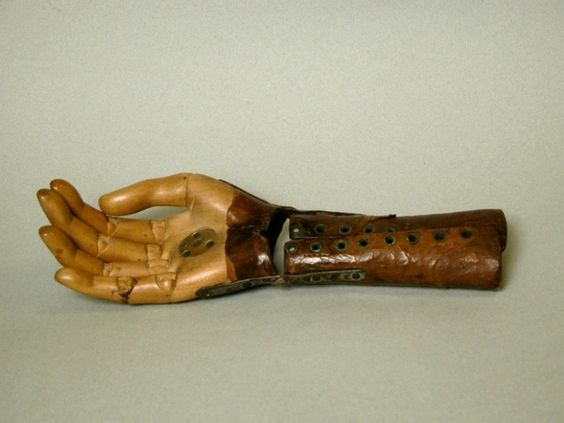
Source: collectmedicalantiques.com
The prosthesis in the photo below was made for a 16-year-old girl who lost her arm below the elbow. The prosthesis is made of wood, leather and fabric. It should be noted that both the appearance of the device and its functionality were thought here: the wrist rotates, the fingers change position, and a hook is added to the palm - so that you can, for example, carry a bag. The prosthesis is presented at the Museum of Science in London.

It looked like dentures of the XIX and XX centuries. Presented in the Museum of Science.
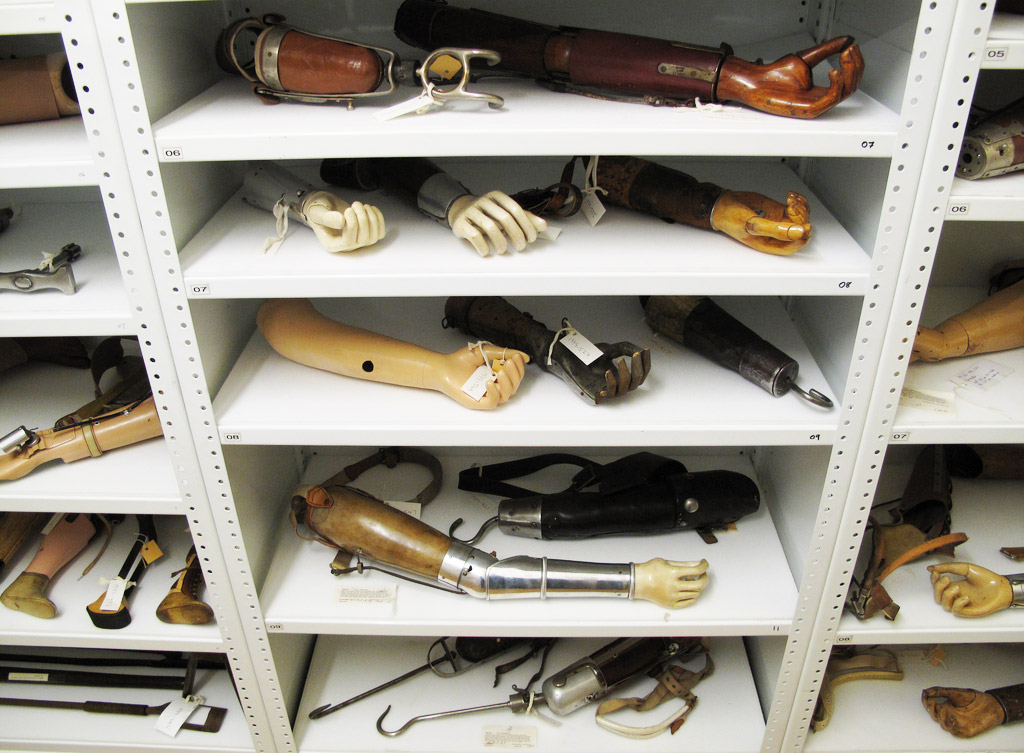
In this photo, a German soldier works in the workshop using a prosthetic left arm. The photograph is contained in the National Museum of the First World War in Kansas.
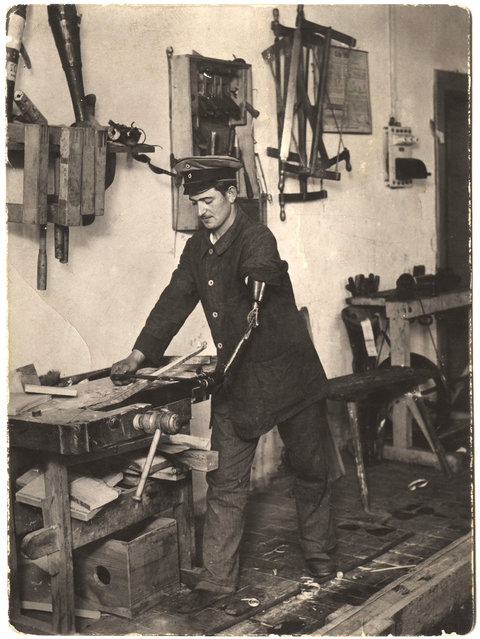
This is a Swiss prosthesis. In the best traditions - with different interchangeable nozzles.
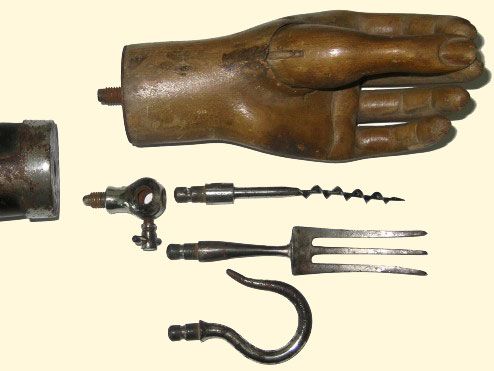
This prosthesis is presented at the Museum of Science in London. He was made for a 17-year-old guy in 1959.

Source: sciencemuseum.org.uk
One of the first recipients of prostheses were soldiers. In this case, the manufacturer of prostheses from Brooklyn on a poster said that he was proud to work with US forces.

As you can see, prostheses of this type have not changed much over several decades.
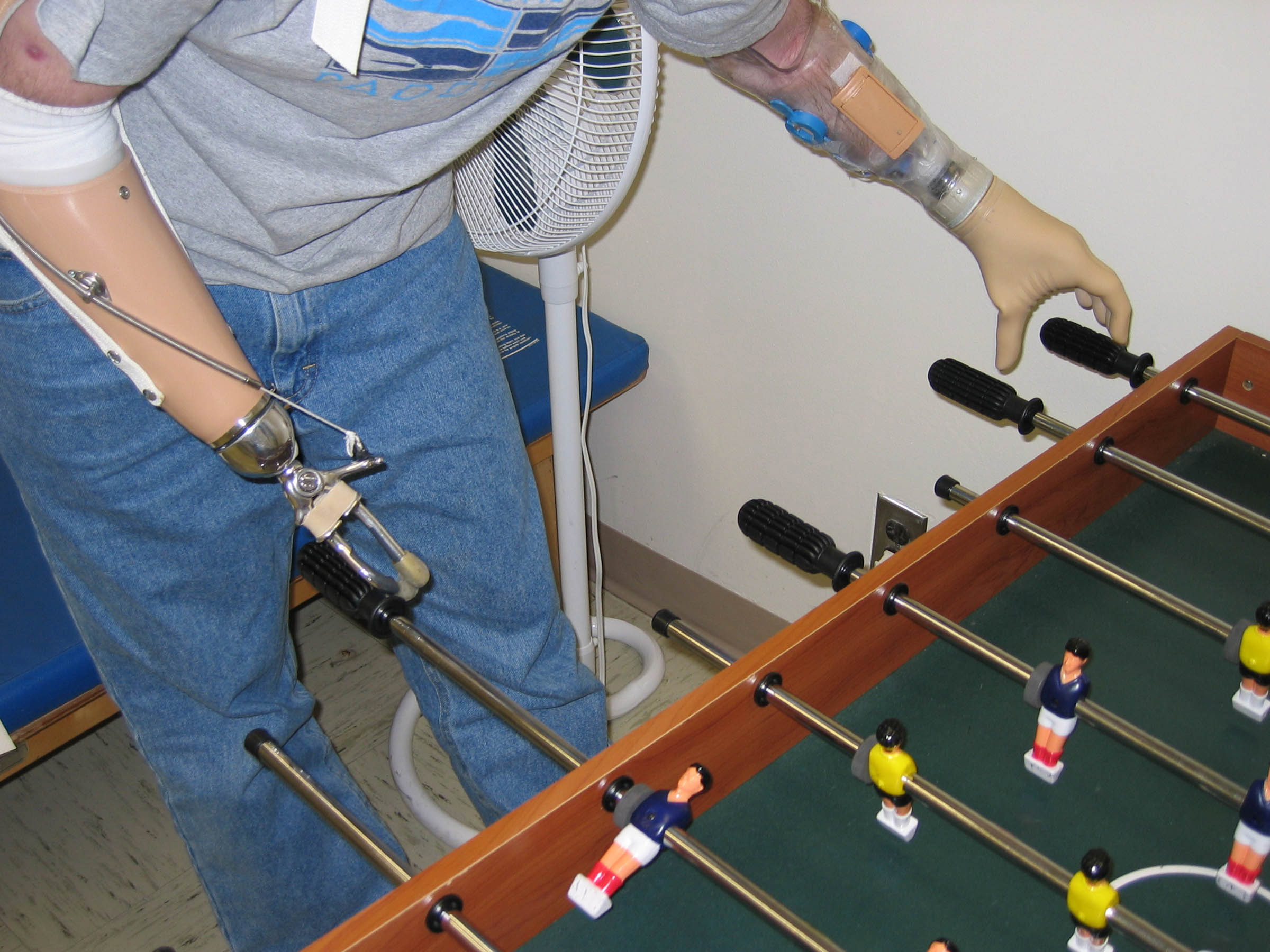
Let's first understand what “bionic prostheses” are. Bionics is an applied science that combines biology and technology. Wildlife helps scientists find solutions for technical devices. There are biological bionics, which studies the processes in biological systems, theoretical, which builds mathematical models of these processes and technical. Technical bionics is important to us now: it uses models of theoretical bionics to solve engineering problems, as is the case with prostheses.
Previously, experts meant by "bionic" prostheses such devices that are similar to the part of the body that they replace. From the point of view of modern concepts, these prostheses are those that are controlled by electronics and biocurrents, that is, they use myography or encephalogram.
The British company RSLSteeper, which currently has about 90 years of experience in prosthetics, brought BeBionic bionic prosthesis to the international market in 2010. At that time, an artificial hand for an adult had only four functional captures, but already allowed to eat, drink, type, turn the key in the lock, use an ATM and hold small items. The user can break eggs with a device and hold a disposable cup in his hand - because even the pressing force is controlled by commands taken from the muscle sensors.
The lack of mass demand and low competition is the main reason why bionic prostheses are very expensive. In 2013, a prosthetic palm cost up to one hundred thousand dollars.
How to reduce the cost of the prosthesis? It is necessary to make its production cheaper. In 2013, the IndieGoGo crowdfunding campaign was successfully completed to create an open and accessible palm prosthesis, most of the details for which can be printed on a 3D printer. The device has independent drives for each finger, tactile feedback and reads signals through the skin to control. In the palm of the device are electric drives and a control board on the Arduino.
<img src = " habrastorage.org/getpro/habr/post_images/79b/967/591/79b9675914c40ef0e466ee254de5e0e9.jpg " width = '600 "alt =" image "/>
The layout of the children's version of Dextrus, stylized by the hand of Iron Man.
Another project, Limbitless Solutions , which makes inexpensive prostheses, in 2015 arranged a meeting for Robert Downey, Jr. and seven-year-old boy Alex, to give the child a bionic prosthesis in the shape of his favorite character's costume arm.
And what is very important - thanks to printing on a 3D printer, the cost of this prosthesis was only $ 350. The project itself makes these prostheses mainly for children whose families cannot afford to spend 30-100 thousand dollars for a bionic arm.
<img src = " habrastorage.org/getpro/geektimes/post_images/97b/0c3/cb9/97b0c3cb9d60525af7e546ed9c73124c.png " width = '600 "alt =" image "/>
In 2014, Johns Hopkins University Hospital developed a prosthesis for both arms and tested it on a person who lost both hands from the shoulder and below. To control the prosthesis, the system reads signals from the pectoral muscles.
One of the most serious players in the world of hand prosthetics in the world is Bebionic. Often in the media say that this company made the first bionic prosthesis. In this video - a demonstration of the capabilities of the myo-electric prosthesis BeBionic 3 from Nigel Ackland, famous in Russia and the world of cyborg.
In June 2016, the first Briton received a Bebionic Small brush - a realistic prosthesis that, due to its small size, is suitable for women and adolescents. Nicky Ashwell, 29, from London, was born without a right hand and used a cosmetic prosthesis that had no functionality for all her life. Judging by the photos, Nicky decided not to wear a glove that mimics human skin.
The Bebionic Small prosthesis weighs 390 grams, is capable of holding up to 45 kilograms and has 14 grips.
<img src = " habrastorage.org/getpro/geektimes/post_images/670/4d5/245/6704d5245a167bd1cb931f503589bc21.jpg " width = '600 "alt =" image "/>
In May 2016, 26-year-old James Young received a prosthesis made to resemble the hand of Solid Snake, the hero of the Metal Gear Solid series of games. James lost his left arm, injured his left leg and suffered other injuries when he fell under the train, and after the hospital received standard prostheses, which he himself described as "ugly." Now he is “running in” another prototype of an artificial hand.

Photo: dailymail.co.uk
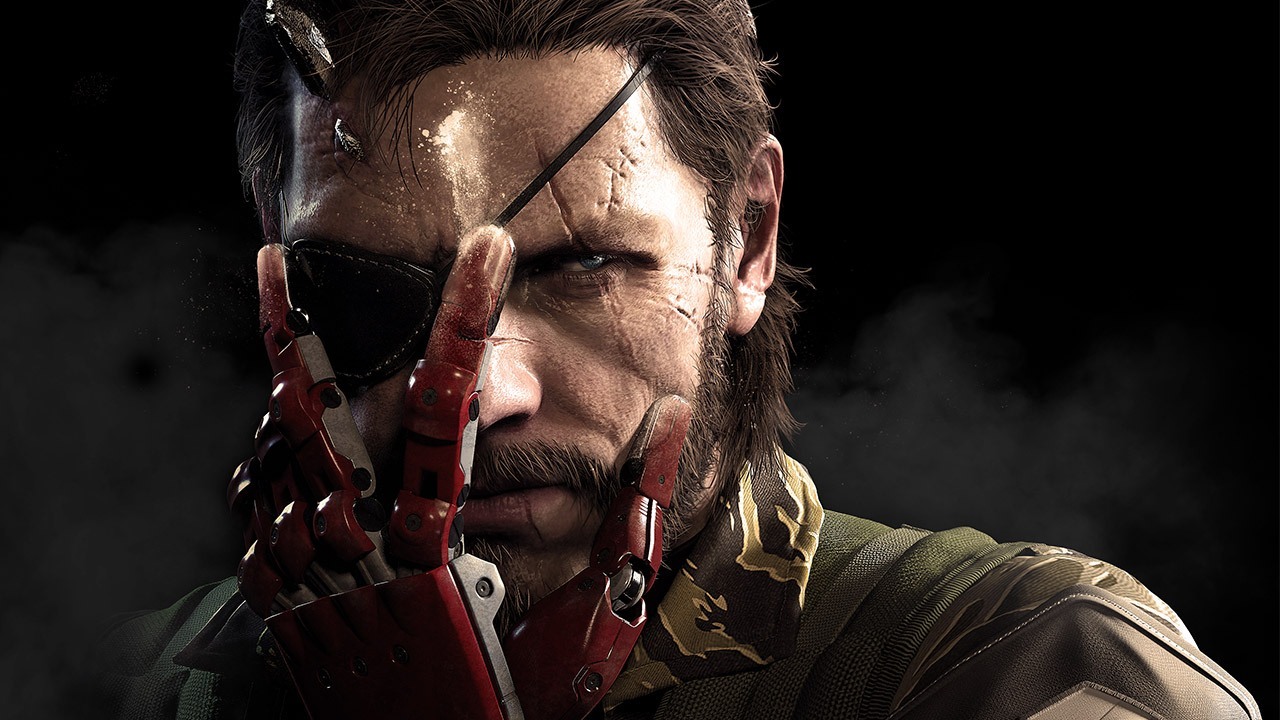
Metal Gear Solid 5
As can be seen from the examples above, modern bionic prostheses have a functional that is sufficient for various household actions. But there is something else that scientists are working on: the sensitivity of prostheses. It is important for a person’s hand to understand how strongly to squeeze something, what exactly can be taken in hand, which is impossible. So with an artificial brush - it will greatly improve the ability to feel.
In 2013, a team from the Cleveland Veterans Affairs Medical Center and Case Western Reserve University developed a prosthesis, whose sensors are directly connected to the nerve endings of the rest of the limb. In this case, the pulses from the sensors do not differ from the pulses that are transmitted by the own hand. The first volunteer who experienced the device, told me what he began to feel "fingers", palm and back of the hand. In the video below, a volunteer tries to tear off a sprig from a cherry — first, with the sensitivity of the artificial hand turned off, then with the included hand. In the second case, he copes better with this task.
In mid-2013, DARPA also introduced a prosthesis with feedback in the framework of the RE-NET (Reliable Neural-Interface Technology) program. The agency was going to work on this project until 2016.
In 2015, a 28-year-old paralyzed patient, using a prosthesis connected to the brain, began to perceive various objects , including touching each finger. This was done in another program - Revolutionizing Prosthetics .
In 2014, Dennis Aabo Sørensen, who lost a hand due to the careless handling of pyrotechnic “toys”, volunteered to test a prosthesis with feedback. The electrodes of the prosthesis connected to the human nervous system . The strength of the signal is calculated by the computer, and Dennis began to feel the size, shape and texture of the object.
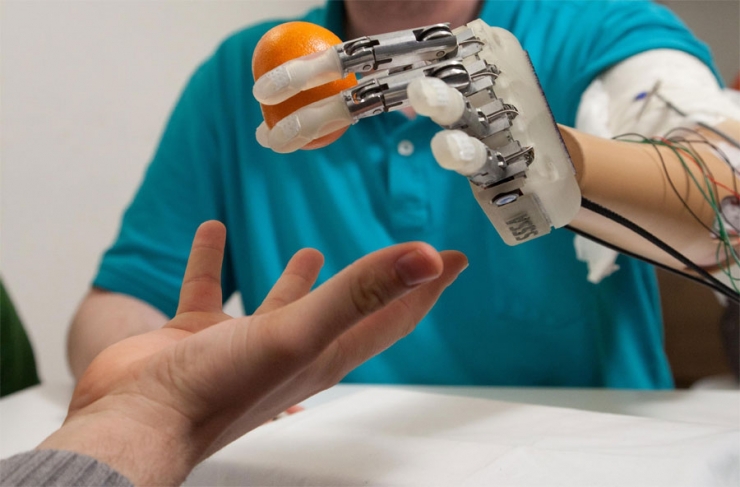
In the Russian market, there are virtually no players who have introduced bionic prosthetic hands into commercial use. The development is conducted by the startup “Motorika”, known for introducing traction prostheses for children into the federal program for providing disabled people with technical means - thanks to this company, children receive traction prostheses at the expense of the state. In this video - tests of the fourth prototype of the artificial brush Stradivary, which the team plans to start producing and installing in Russia in October-November 2016.
Stradivary prosthesis - myoelectric. To install it does not require surgery. Surface sensor sensors are built into the receiving sleeve, they touch certain places on the skin in the area of the muscles, pick up the potential with the contraction of the muscle and transmit a signal to open or close the hand.
The main problem encountered when installing this type of prosthesis is poorly developed muscles of the forearm. To avoid this problem, “Motorika” makes traction mechanical prostheses for children - such prostheses not only help to perform various functions of the hand, but also serve as a simulator.
According to Ilya Chekh, the founder of Motorika, now there are two directions for the development of bionic prostheses.
The first is sensation, that is, feedback, which allows the owner of the prosthesis to obtain information about the qualities of the object to which he touches the device.
The second is the implantation of all elements, including the frame and the sensor. One of the problems with the prosthesis of James Young, who received a hand similar to that of Metal Gear Solid, is the need to remove such a prosthesis for sleeping or taking a shower. In the future, dentures will more likely resemble the hand of the protagonist of the film I, the Robot, played by Will Smith. Not in terms of compliance with their own limbs, but in terms of the lack of need for additional care.
Now in the world is very popular inexpensive printing direction in prosthetics. The availability and distribution of 3D printers led to this. There are various projects that help to get free traction prostheses, and schemes with which you can modify and print the myoelectric prosthesis of the arm. Ilya Cech considers this trend to be temporary: it will be popular for the next 10-12 years, while the implantable technologies will develop and scale. 3D printing now offers a lower cost, but significantly loses in quality. And the best quality in comparison with traditional technologies it most likely will never give. It will always be cheaper and more qualitative to cut off on a sheet metal laser than to print with polymers using a printer. At least it will be, if you think in the existing paradigm of print development, and not fantasize about the molecular construction of objects. The print is designed to minimize the time and cost of prototyping and R & D.
How do you see the future of human hand prosthetics? What methods of installation and management seem to you most in demand in 20-30 years?
In this article we will talk about hand prosthetics. Here we will not touch the topic of the teeth, eyes, ears, face, internal organs of a person and even the legs. And let's start from the Middle Ages, when amputation was one of the most effective ways to fight infections. The theme will continue the devices of the Victorian era and modern bionic prostheses, and at the end we will discuss the future of this area.

Steel hands of knights
This prosthetic arm, made of steel, dates from the 16th century. It has double fingers and a thumb, which can take certain positions. The control took place with the help of a button on the back of the palm. This device is one of the three Chevalier prostheses Götz von Berlichingen . The device allowed to take objects in their hands and, perhaps, even to write with a pen.
')


This is another hand knight .

Inside this iron arm , made in the 17th century, there was a mechanism that allowed the rest of the arm to bend to control the clenched fist. This was apparently the prototype of modern traction prostheses.

This wooden prosthesis was supposedly made in 1800.

Another wooden prosthesis allegedly controlled with a cable. The artificial arm is represented in the Smithsonian Museum.

Source: invention.smithsonian.org
Less wealthy people could use hook prostheses like this device from the beginning of the 19th century. When I took this article, I was sure that only such prostheses were before the XX century.

The elbow, wrist, and fingers of this prosthesis , made between 1850 and 1910, can move. Probably, they put a glove on this iron hand. Although the device looks very interesting.
In 2013, a post about a miracle prosthesis from Holland was written on Habrahabr. The post contained a scan from the Journal of the Ministry of National Education No. 7 of 1837, which described "the mechanical hand of a new device that can completely replace the loss of these precious members." Two such hands, which you can swing, move your fingers and take objects, gave the two soldiers. Judging by the previous examples of prostheses, which are stored in various museums and described by historians and scholars, this article still could not be a duck, as users thought.

The photo below shows a veteran of the US Civil War of 1861-1865.

In the palm of this female artificial hand of the XIX century, holes are visible, which may have been used to fasten a hook or other devices that simplify life.

Source: collectmedicalantiques.com
XX century
The prosthesis in the photo below was made for a 16-year-old girl who lost her arm below the elbow. The prosthesis is made of wood, leather and fabric. It should be noted that both the appearance of the device and its functionality were thought here: the wrist rotates, the fingers change position, and a hook is added to the palm - so that you can, for example, carry a bag. The prosthesis is presented at the Museum of Science in London.

It looked like dentures of the XIX and XX centuries. Presented in the Museum of Science.

In this photo, a German soldier works in the workshop using a prosthetic left arm. The photograph is contained in the National Museum of the First World War in Kansas.

This is a Swiss prosthesis. In the best traditions - with different interchangeable nozzles.

This prosthesis is presented at the Museum of Science in London. He was made for a 17-year-old guy in 1959.

Source: sciencemuseum.org.uk
One of the first recipients of prostheses were soldiers. In this case, the manufacturer of prostheses from Brooklyn on a poster said that he was proud to work with US forces.

As you can see, prostheses of this type have not changed much over several decades.

Modern bionic prostheses
Let's first understand what “bionic prostheses” are. Bionics is an applied science that combines biology and technology. Wildlife helps scientists find solutions for technical devices. There are biological bionics, which studies the processes in biological systems, theoretical, which builds mathematical models of these processes and technical. Technical bionics is important to us now: it uses models of theoretical bionics to solve engineering problems, as is the case with prostheses.
Previously, experts meant by "bionic" prostheses such devices that are similar to the part of the body that they replace. From the point of view of modern concepts, these prostheses are those that are controlled by electronics and biocurrents, that is, they use myography or encephalogram.
The British company RSLSteeper, which currently has about 90 years of experience in prosthetics, brought BeBionic bionic prosthesis to the international market in 2010. At that time, an artificial hand for an adult had only four functional captures, but already allowed to eat, drink, type, turn the key in the lock, use an ATM and hold small items. The user can break eggs with a device and hold a disposable cup in his hand - because even the pressing force is controlled by commands taken from the muscle sensors.
The lack of mass demand and low competition is the main reason why bionic prostheses are very expensive. In 2013, a prosthetic palm cost up to one hundred thousand dollars.
How to reduce the cost of the prosthesis? It is necessary to make its production cheaper. In 2013, the IndieGoGo crowdfunding campaign was successfully completed to create an open and accessible palm prosthesis, most of the details for which can be printed on a 3D printer. The device has independent drives for each finger, tactile feedback and reads signals through the skin to control. In the palm of the device are electric drives and a control board on the Arduino.
<img src = " habrastorage.org/getpro/habr/post_images/79b/967/591/79b9675914c40ef0e466ee254de5e0e9.jpg " width = '600 "alt =" image "/>
The layout of the children's version of Dextrus, stylized by the hand of Iron Man.
Another project, Limbitless Solutions , which makes inexpensive prostheses, in 2015 arranged a meeting for Robert Downey, Jr. and seven-year-old boy Alex, to give the child a bionic prosthesis in the shape of his favorite character's costume arm.
And what is very important - thanks to printing on a 3D printer, the cost of this prosthesis was only $ 350. The project itself makes these prostheses mainly for children whose families cannot afford to spend 30-100 thousand dollars for a bionic arm.
<img src = " habrastorage.org/getpro/geektimes/post_images/97b/0c3/cb9/97b0c3cb9d60525af7e546ed9c73124c.png " width = '600 "alt =" image "/>
In 2014, Johns Hopkins University Hospital developed a prosthesis for both arms and tested it on a person who lost both hands from the shoulder and below. To control the prosthesis, the system reads signals from the pectoral muscles.
One of the most serious players in the world of hand prosthetics in the world is Bebionic. Often in the media say that this company made the first bionic prosthesis. In this video - a demonstration of the capabilities of the myo-electric prosthesis BeBionic 3 from Nigel Ackland, famous in Russia and the world of cyborg.
In June 2016, the first Briton received a Bebionic Small brush - a realistic prosthesis that, due to its small size, is suitable for women and adolescents. Nicky Ashwell, 29, from London, was born without a right hand and used a cosmetic prosthesis that had no functionality for all her life. Judging by the photos, Nicky decided not to wear a glove that mimics human skin.
The Bebionic Small prosthesis weighs 390 grams, is capable of holding up to 45 kilograms and has 14 grips.
<img src = " habrastorage.org/getpro/geektimes/post_images/670/4d5/245/6704d5245a167bd1cb931f503589bc21.jpg " width = '600 "alt =" image "/>
In May 2016, 26-year-old James Young received a prosthesis made to resemble the hand of Solid Snake, the hero of the Metal Gear Solid series of games. James lost his left arm, injured his left leg and suffered other injuries when he fell under the train, and after the hospital received standard prostheses, which he himself described as "ugly." Now he is “running in” another prototype of an artificial hand.

Photo: dailymail.co.uk

Metal Gear Solid 5
As can be seen from the examples above, modern bionic prostheses have a functional that is sufficient for various household actions. But there is something else that scientists are working on: the sensitivity of prostheses. It is important for a person’s hand to understand how strongly to squeeze something, what exactly can be taken in hand, which is impossible. So with an artificial brush - it will greatly improve the ability to feel.
In 2013, a team from the Cleveland Veterans Affairs Medical Center and Case Western Reserve University developed a prosthesis, whose sensors are directly connected to the nerve endings of the rest of the limb. In this case, the pulses from the sensors do not differ from the pulses that are transmitted by the own hand. The first volunteer who experienced the device, told me what he began to feel "fingers", palm and back of the hand. In the video below, a volunteer tries to tear off a sprig from a cherry — first, with the sensitivity of the artificial hand turned off, then with the included hand. In the second case, he copes better with this task.
In mid-2013, DARPA also introduced a prosthesis with feedback in the framework of the RE-NET (Reliable Neural-Interface Technology) program. The agency was going to work on this project until 2016.
In 2015, a 28-year-old paralyzed patient, using a prosthesis connected to the brain, began to perceive various objects , including touching each finger. This was done in another program - Revolutionizing Prosthetics .
In 2014, Dennis Aabo Sørensen, who lost a hand due to the careless handling of pyrotechnic “toys”, volunteered to test a prosthesis with feedback. The electrodes of the prosthesis connected to the human nervous system . The strength of the signal is calculated by the computer, and Dennis began to feel the size, shape and texture of the object.

Bionic prostheses in Russia
In the Russian market, there are virtually no players who have introduced bionic prosthetic hands into commercial use. The development is conducted by the startup “Motorika”, known for introducing traction prostheses for children into the federal program for providing disabled people with technical means - thanks to this company, children receive traction prostheses at the expense of the state. In this video - tests of the fourth prototype of the artificial brush Stradivary, which the team plans to start producing and installing in Russia in October-November 2016.
Stradivary prosthesis - myoelectric. To install it does not require surgery. Surface sensor sensors are built into the receiving sleeve, they touch certain places on the skin in the area of the muscles, pick up the potential with the contraction of the muscle and transmit a signal to open or close the hand.
The main problem encountered when installing this type of prosthesis is poorly developed muscles of the forearm. To avoid this problem, “Motorika” makes traction mechanical prostheses for children - such prostheses not only help to perform various functions of the hand, but also serve as a simulator.
According to Ilya Chekh, the founder of Motorika, now there are two directions for the development of bionic prostheses.
The first is sensation, that is, feedback, which allows the owner of the prosthesis to obtain information about the qualities of the object to which he touches the device.
The second is the implantation of all elements, including the frame and the sensor. One of the problems with the prosthesis of James Young, who received a hand similar to that of Metal Gear Solid, is the need to remove such a prosthesis for sleeping or taking a shower. In the future, dentures will more likely resemble the hand of the protagonist of the film I, the Robot, played by Will Smith. Not in terms of compliance with their own limbs, but in terms of the lack of need for additional care.
Now in the world is very popular inexpensive printing direction in prosthetics. The availability and distribution of 3D printers led to this. There are various projects that help to get free traction prostheses, and schemes with which you can modify and print the myoelectric prosthesis of the arm. Ilya Cech considers this trend to be temporary: it will be popular for the next 10-12 years, while the implantable technologies will develop and scale. 3D printing now offers a lower cost, but significantly loses in quality. And the best quality in comparison with traditional technologies it most likely will never give. It will always be cheaper and more qualitative to cut off on a sheet metal laser than to print with polymers using a printer. At least it will be, if you think in the existing paradigm of print development, and not fantasize about the molecular construction of objects. The print is designed to minimize the time and cost of prototyping and R & D.
How do you see the future of human hand prosthetics? What methods of installation and management seem to you most in demand in 20-30 years?
Source: https://habr.com/ru/post/394579/
All Articles